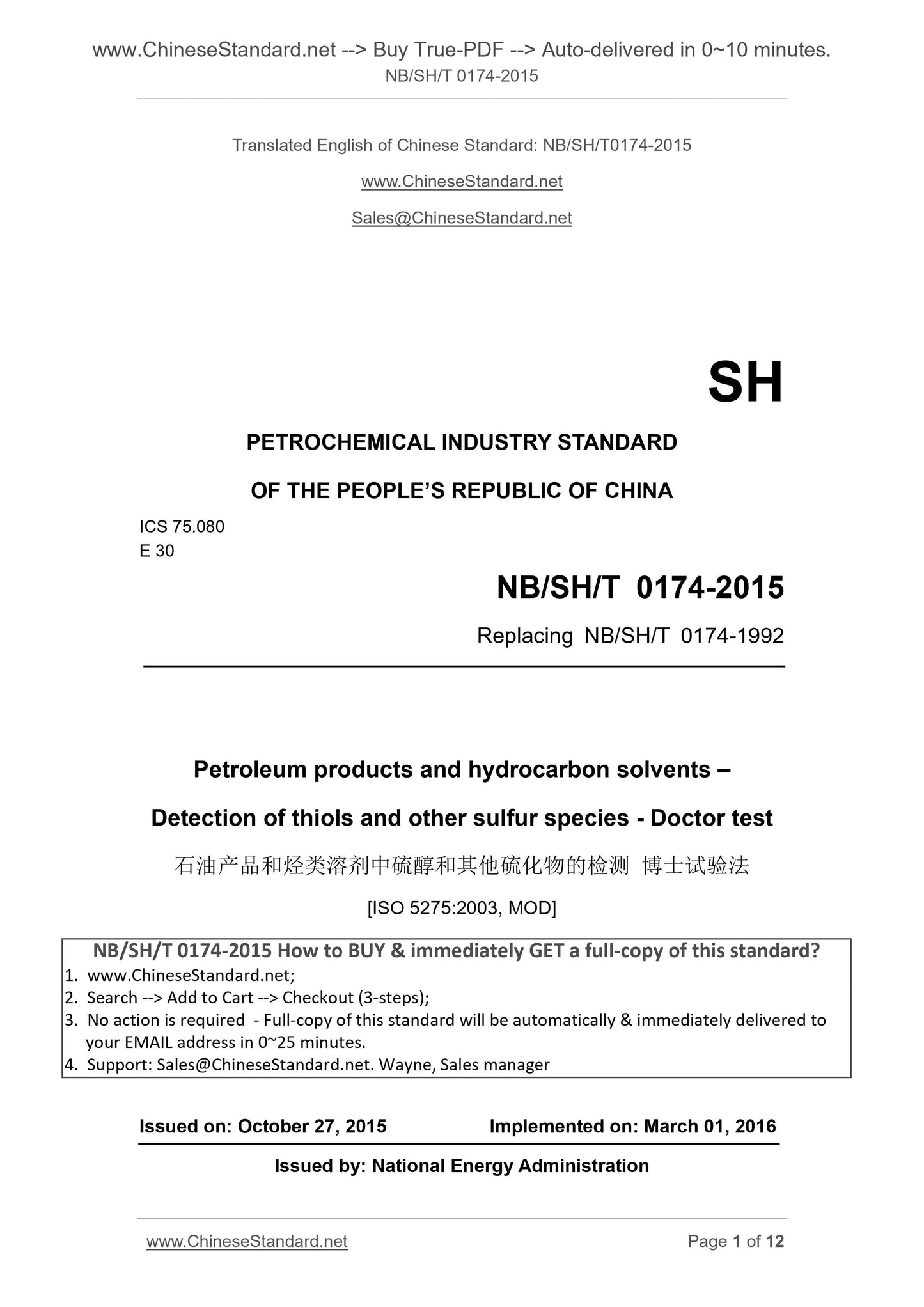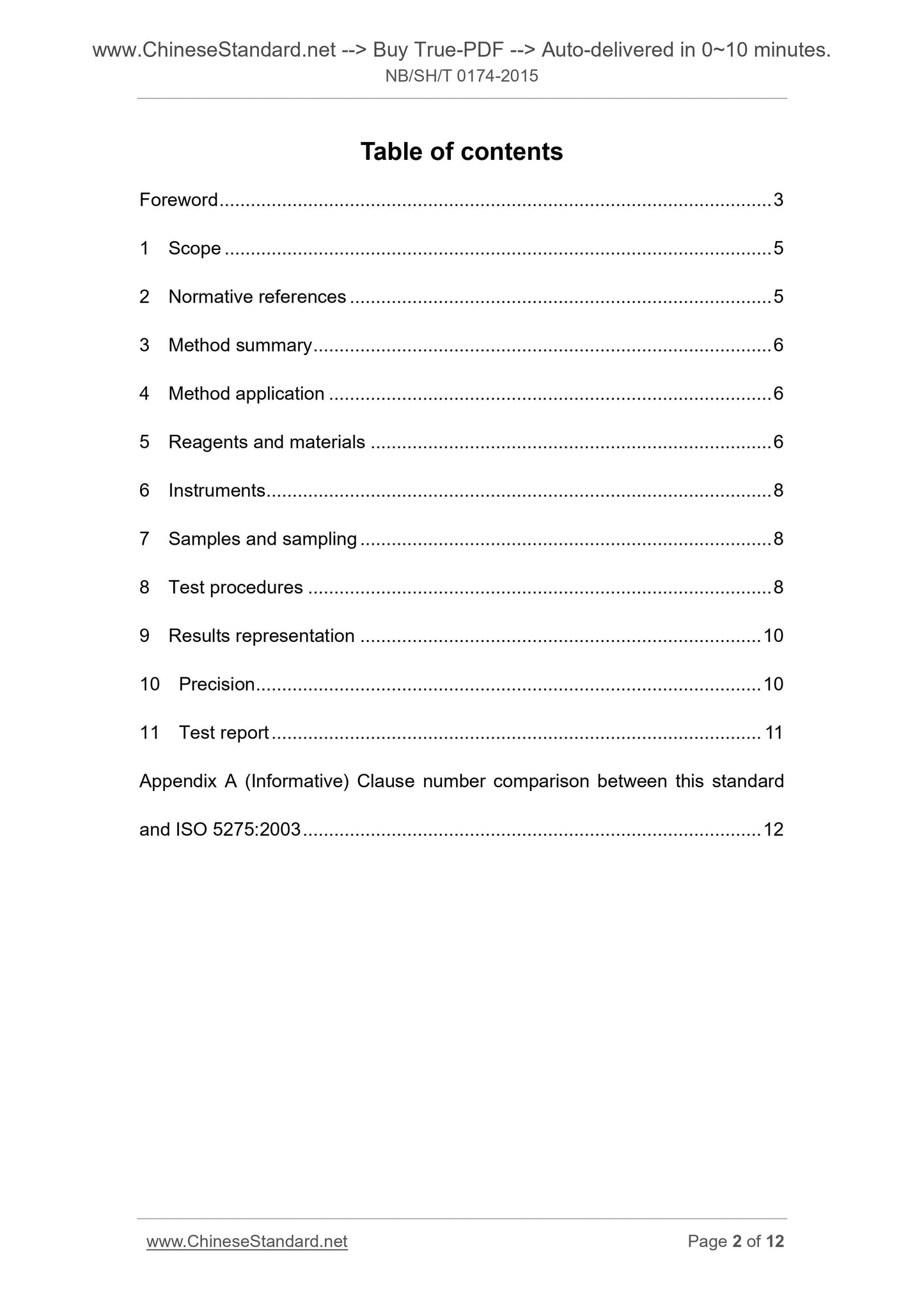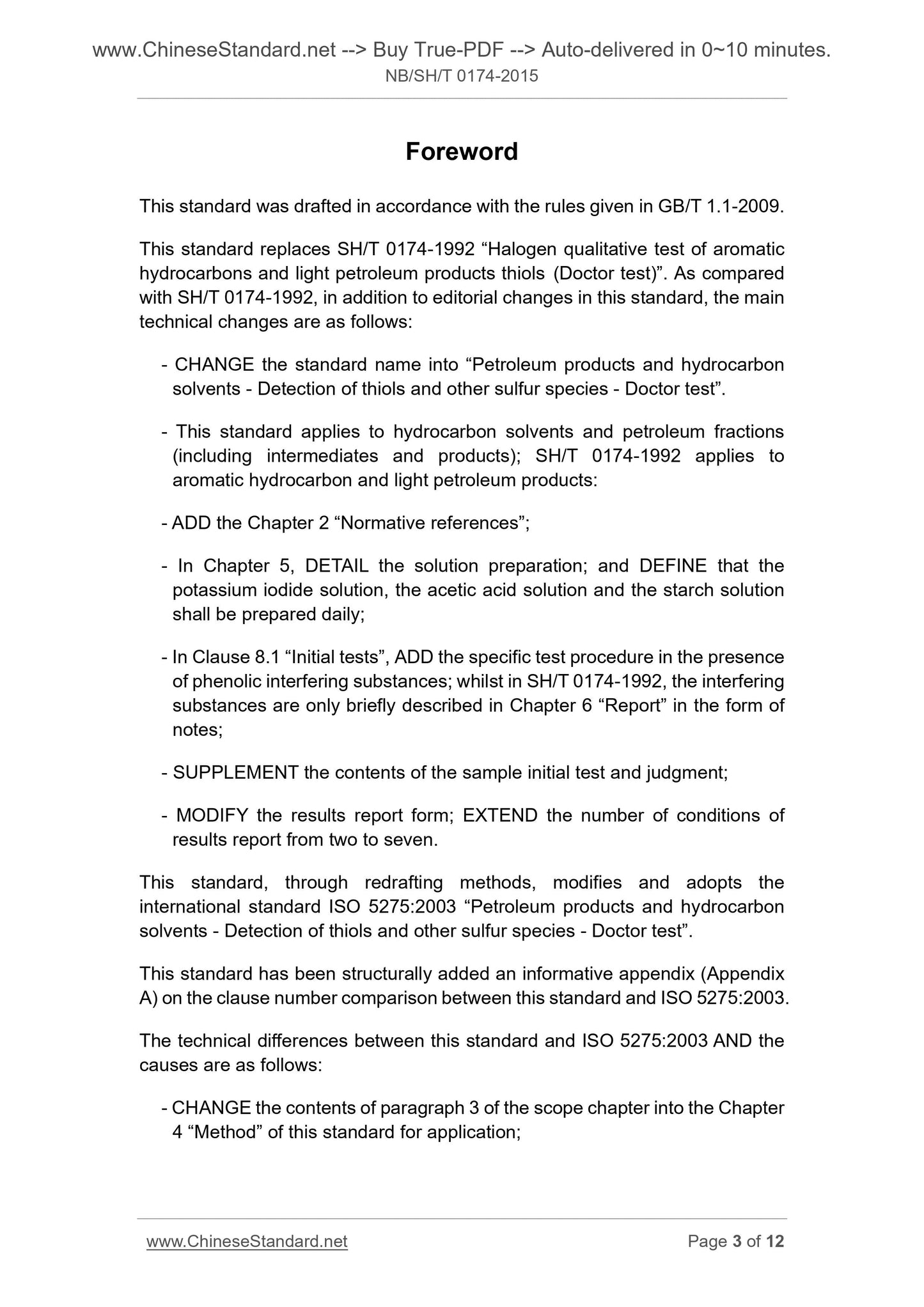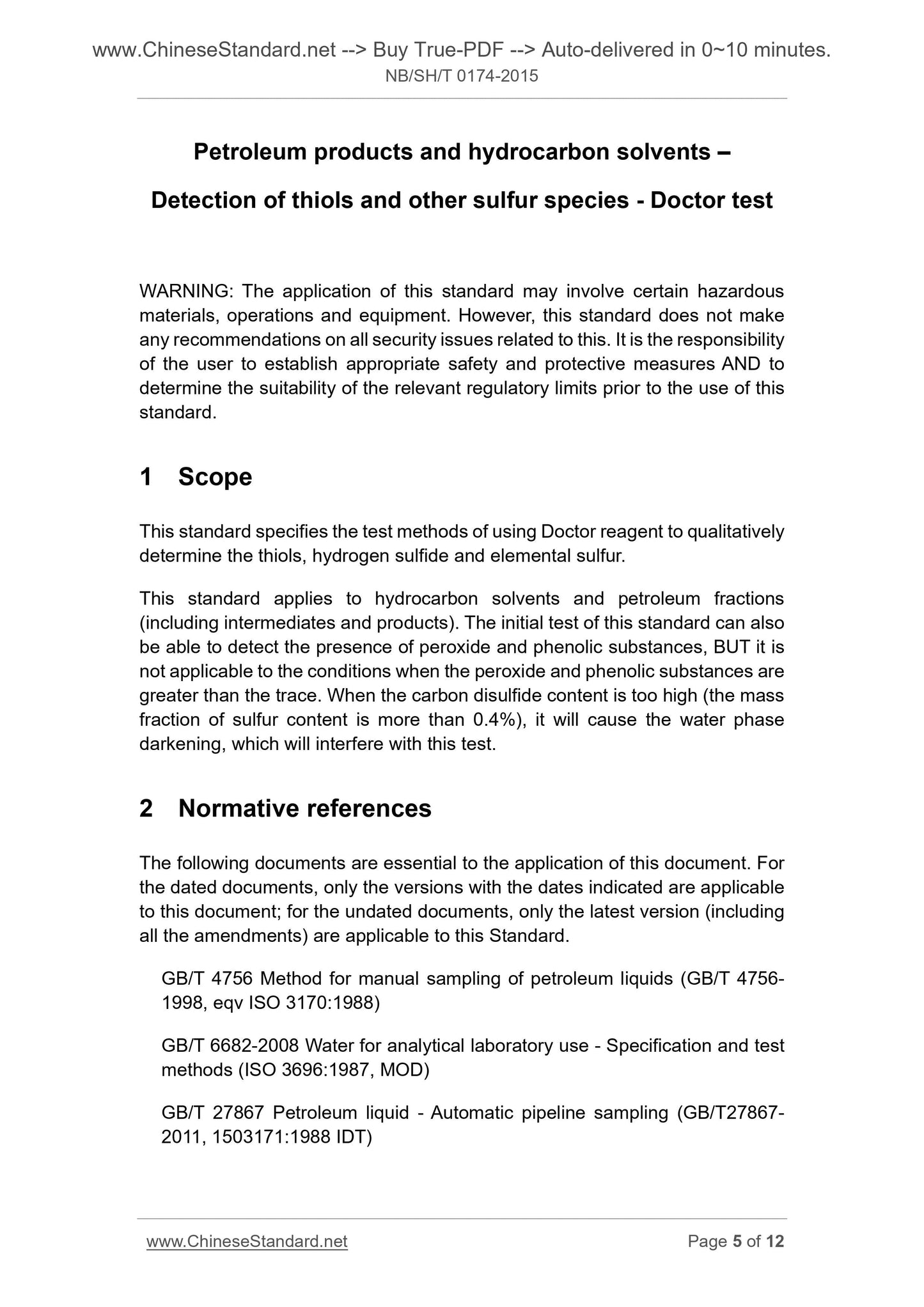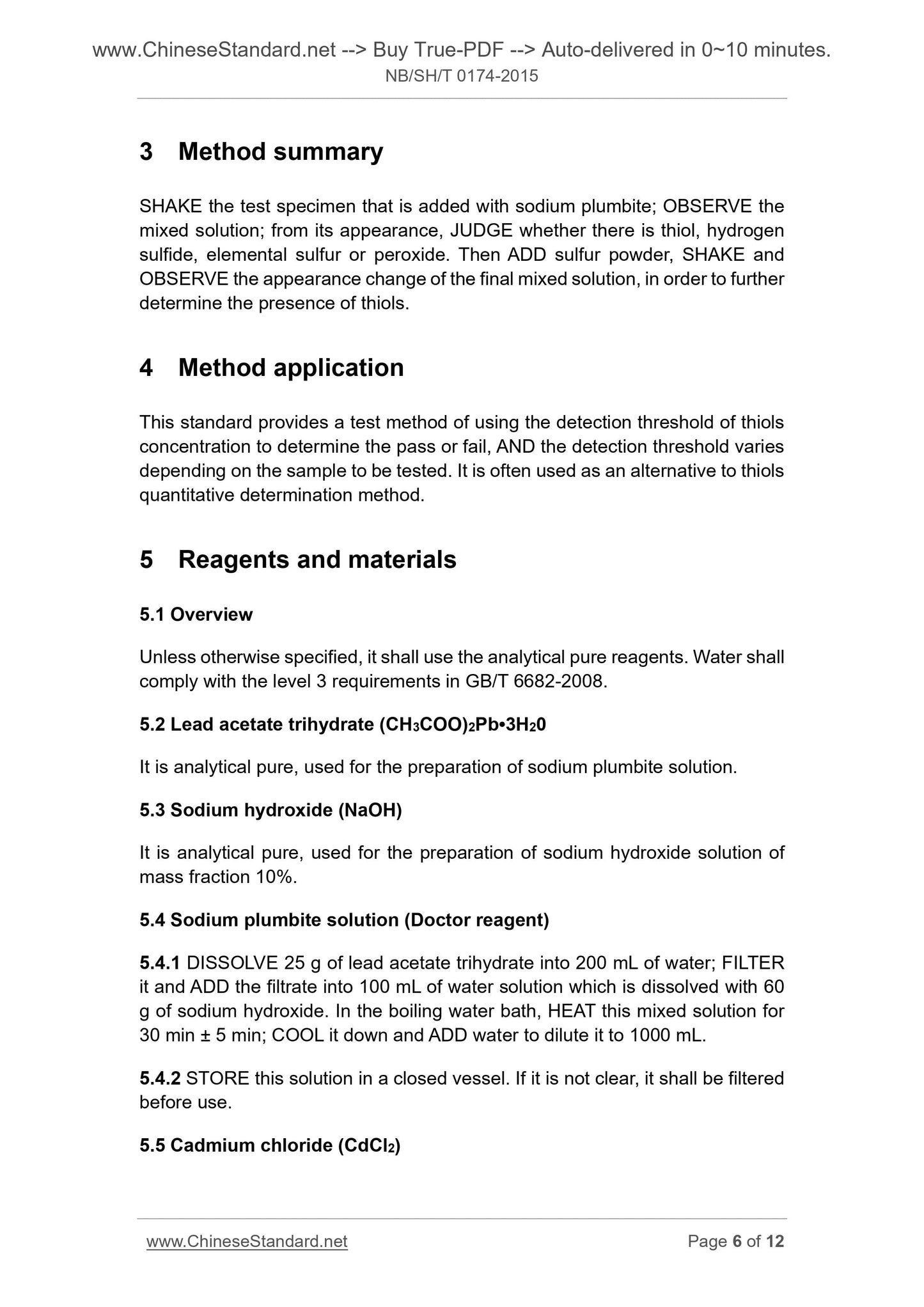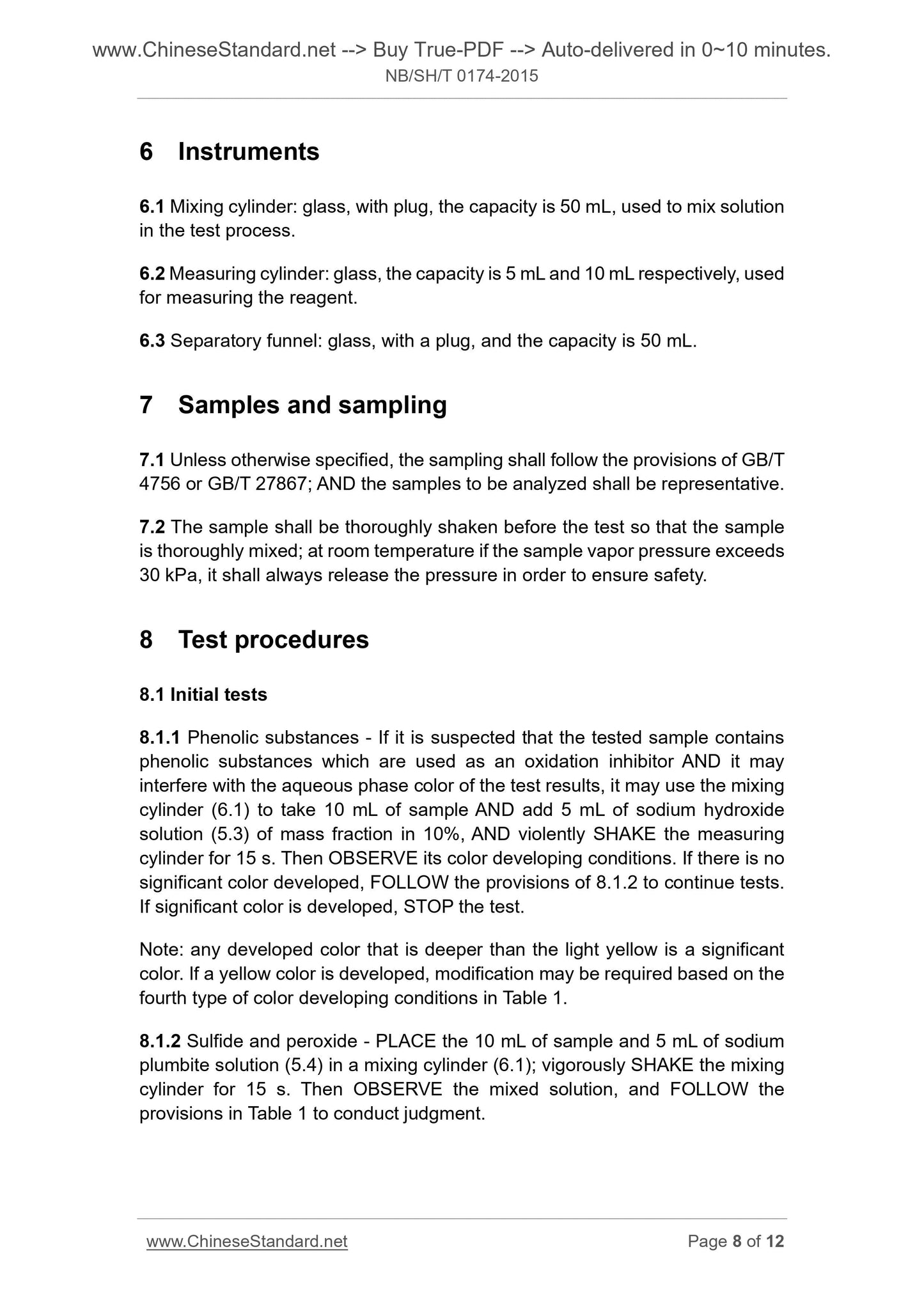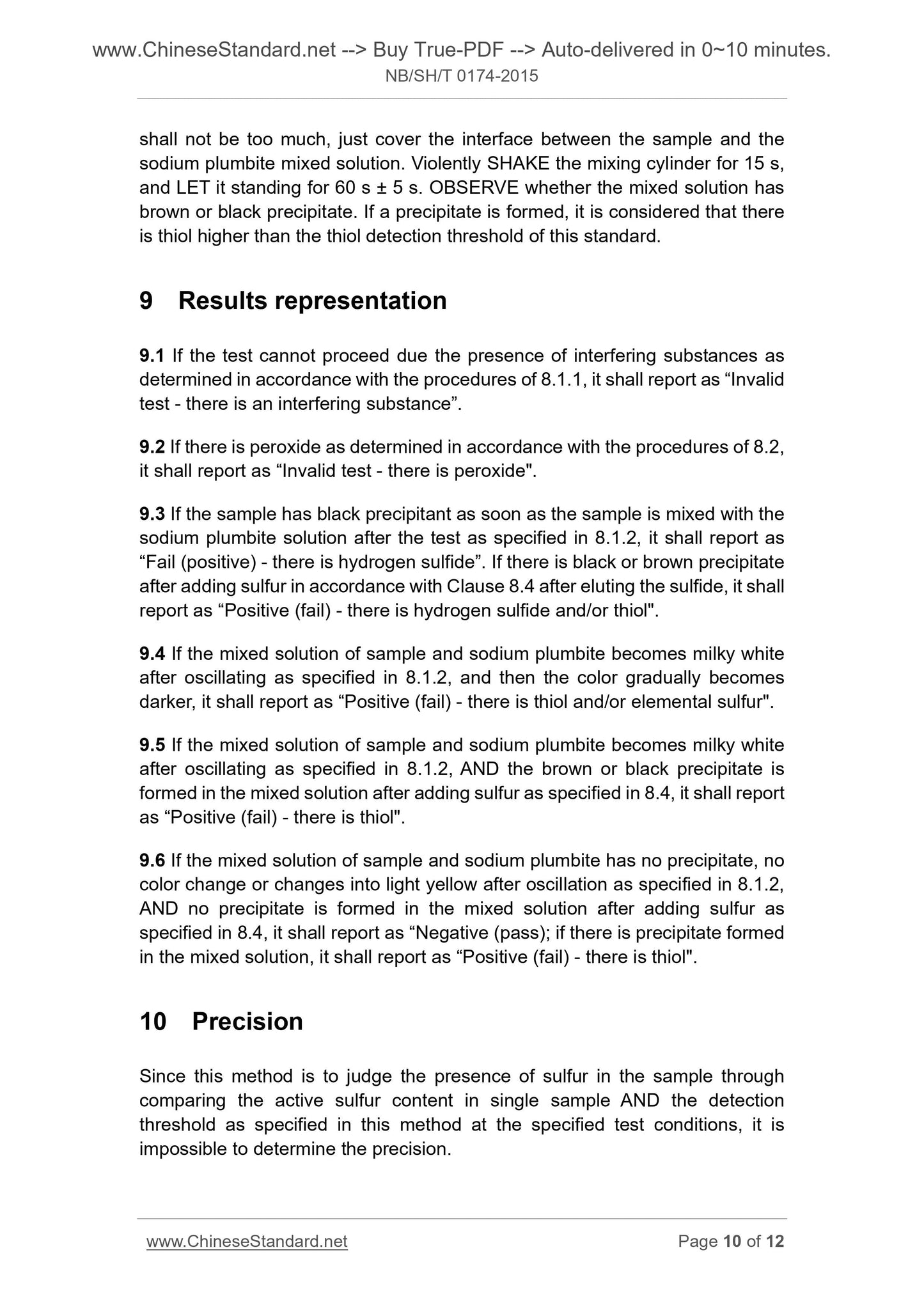1
/
of
7
PayPal, credit cards. Download editable-PDF and invoice in 1 second!
NB/SH/T 0174-2015 English PDF (NB/SH/T0174-2015)
NB/SH/T 0174-2015 English PDF (NB/SH/T0174-2015)
Regular price
$110.00 USD
Regular price
Sale price
$110.00 USD
Unit price
/
per
Shipping calculated at checkout.
Couldn't load pickup availability
Delivery: 3 seconds. Download true-PDF + Invoice.
Get QUOTATION in 1-minute: Click NB/SH/T 0174-2015
Historical versions: NB/SH/T 0174-2015
Preview True-PDF (Reload/Scroll if blank)
NB/SH/T 0174-2015: Petroleum products and hydrocarbon solvents – Detection of thiols and other sulfur species - Doctor test
NB/SH/T 0174-2015
SH
PETROCHEMICAL INDUSTRY STANDARD
OF THE PEOPLE’S REPUBLIC OF CHINA
ICS 75.080
E 30
Replacing NB/SH/T 0174-1992
Petroleum products and hydrocarbon solvents –
Detection of thiols and other sulfur species - Doctor test
[ISO 5275.2003, MOD]
ISSUED ON. OCTOBER 27, 2015
IMPLEMENTED ON. MARCH 01, 2016
Issued by. National Energy Administration
Table of contents
Foreword ... 3
1 Scope ... 5
2 Normative references ... 5
3 Method summary ... 6
4 Method application ... 6
5 Reagents and materials ... 6
6 Instruments ... 8
7 Samples and sampling ... 8
8 Test procedures ... 8
9 Results representation ... 10
10 Precision ... 10
11 Test report ... 11
Appendix A (Informative) Clause number comparison between this standard
and ISO 5275.2003 ... 12
Foreword
This standard was drafted in accordance with the rules given in GB/T 1.1-2009.
This standard replaces SH/T 0174-1992 “Halogen qualitative test of aromatic
hydrocarbons and light petroleum products thiols (Doctor test)”. As compared
with SH/T 0174-1992, in addition to editorial changes in this standard, the main
technical changes are as follows.
- CHANGE the standard name into “Petroleum products and hydrocarbon
solvents - Detection of thiols and other sulfur species - Doctor test”.
- This standard applies to hydrocarbon solvents and petroleum fractions
(including intermediates and products); SH/T 0174-1992 applies to
aromatic hydrocarbon and light petroleum products.
- ADD the Chapter 2 “Normative references”;
- In Chapter 5, DETAIL the solution preparation; and DEFINE that the
potassium iodide solution, the acetic acid solution and the starch solution
shall be prepared daily;
- In Clause 8.1 “Initial tests”, ADD the specific test procedure in the presence
of phenolic interfering substances; whilst in SH/T 0174-1992, the interfering
substances are only briefly described in Chapter 6 “Report” in the form of
notes;
- SUPPLEMENT the contents of the sample initial test and judgment;
- MODIFY the results report form; EXTEND the number of conditions of
results report from two to seven.
This standard, through redrafting methods, modifies and adopts the
international standard ISO 5275.2003 “Petroleum products and hydrocarbon
solvents - Detection of thiols and other sulfur species - Doctor test”.
This standard has been structurally added an informative appendix (Appendix
A) on the clause number comparison between this standard and ISO 5275.2003.
The technical differences between this standard and ISO 5275.2003 AND the
causes are as follows.
- CHANGE the contents of paragraph 3 of the scope chapter into the Chapter
4 “Method” of this standard for application;
Petroleum products and hydrocarbon solvents –
Detection of thiols and other sulfur species - Doctor test
WARNING. The application of this standard may involve certain hazardous
materials, operations and equipment. However, this standard does not make
any recommendations on all security issues related to this. It is the responsibility
of the user to establish appropriate safety and protective measures AND to
determine the suitability of the relevant regulatory limits prior to the use of this
standard.
1 Scope
This standard specifies the test methods of using Doctor reagent to qualitatively
determine the thiols, hydrogen sulfide and elemental sulfur.
This standard applies to hydrocarbon solvents and petroleum fractions
(including intermediates and products). The initial test of this standard can also
be able to detect the presence of peroxide and phenolic substances, BUT it is
not applicable to the conditions when the peroxide and phenolic substances are
greater than the trace. When the carbon disulfide content is too high (the mass
fraction of sulfur content is more than 0.4%), it will cause the water phase
darkening, which will interfere with this test.
2 Normative references
The following documents are essential to the application of this document. For
the dated documents, only the versions with the dates indicated are applicable
to this document; for the undated documents, only the latest version (including
all the amendments) are applicable to this Standard.
GB/T 4756 Method for manual sampling of petroleum liquids (GB/T 4756-
1998, eqv ISO 3170.1988)
GB/T 6682-2008 Water for analytical laboratory use - Specification and test
methods (ISO 3696.1987, MOD)
GB/T 27867 Petroleum liquid - Automatic pipeline sampling (GB/T27867-
2011, 1503171.1988 IDT)
3 Method summary
SHAKE the test specimen that is added with sodium plumbite; OBSERVE the
mixed solution; from its appearance, JUDGE whether there is thiol, hydrogen
sulfide, elemental sulfur or peroxide. Then ADD sulfur powder, SHAKE and
OBSERVE the appearance change of the final mixed solution, in order to further
determine the presence of thiols.
4 Method application
This standard provides a test method of using the detection threshold of thiols
concentration to determine the pass or fail, AND the detection threshold varies
depending on the sample to be tested. It is often used as an alternative to thiols
quantitative determination method.
5 Reagents and materials
5.1 Overview
Unless otherwise specified, it shall use the analytical pure reagents. Water shall
comply with the level 3 requirements in GB/T 6682-2008.
5.2 Lead acetate trihydrate (CH3COO)2Pb•3H20
It is analytical pure, used for the preparation of sodium plumbite solution.
5.3 Sodium hydroxide (NaOH)
It is analytical pure, used for the preparation of sodium hydroxide solution of
mass fraction 10%.
5.4 Sodium plumbite solution (Doctor reagent)
5.4.1 DISSOLVE 25 g of lead acetate trihydrate into 200 mL of water; FILTER
it and ADD the filtrate into 100 mL of water solution which is dissolved with 60
g of sodium hydroxide. In the boiling water bath, HEAT this mixed solution for
30 min ± 5 min; COOL it down and ADD water to dilute it to 1000 mL.
5.4.2 STORE this solution in a closed vessel. If it is not clear, it shall be filtered
before use.
5.5 Cadmium chloride (CdCl2)
6 Instruments
6.1 Mixing cylinder. glass, with plug, the capacity is 50 mL, used to mix solution
in the test process.
6.2 Measuring cylinder. glass, the capacity is 5 mL and 10 mL respectively, used
for measuring the reagent.
6.3 Separatory funnel. glass, with a plug, and the capacity is 50 mL.
7 Samples and sampling
7.1 Unless otherwise specified, the sampling shall follow the provisions of GB/T
4756 or GB/T 27867; AND the samples to be analyzed shall be representative.
7.2 The sample shall be thoroughly shaken before the test so that the sample
is thoroughly mixed; at room temperature if the sample vapor pressure exceeds
30 kPa, it shall always release the pressure in order to ensure safety.
8 Test procedures
8.1 Initial tests
8.1.1 Phenolic substances - If it is suspected that the tested sample contains
phenolic substances which are used as an oxidation inhibitor AND it may
interfere with the aqueous phase color of the test results, it may use the mixing
cylinder (6.1) to take 10 mL of sample AND add 5 mL of sodium hydroxide
solution (5.3) of mass fraction in 10%, AND violently SHAKE the measuring
cylinder for 15 s. Then OBSERVE its color developing conditions. If there is no
significant color developed, FOLLOW the provisions of 8.1.2 to continue tests.
If significant color is developed, STOP t...
Get QUOTATION in 1-minute: Click NB/SH/T 0174-2015
Historical versions: NB/SH/T 0174-2015
Preview True-PDF (Reload/Scroll if blank)
NB/SH/T 0174-2015: Petroleum products and hydrocarbon solvents – Detection of thiols and other sulfur species - Doctor test
NB/SH/T 0174-2015
SH
PETROCHEMICAL INDUSTRY STANDARD
OF THE PEOPLE’S REPUBLIC OF CHINA
ICS 75.080
E 30
Replacing NB/SH/T 0174-1992
Petroleum products and hydrocarbon solvents –
Detection of thiols and other sulfur species - Doctor test
[ISO 5275.2003, MOD]
ISSUED ON. OCTOBER 27, 2015
IMPLEMENTED ON. MARCH 01, 2016
Issued by. National Energy Administration
Table of contents
Foreword ... 3
1 Scope ... 5
2 Normative references ... 5
3 Method summary ... 6
4 Method application ... 6
5 Reagents and materials ... 6
6 Instruments ... 8
7 Samples and sampling ... 8
8 Test procedures ... 8
9 Results representation ... 10
10 Precision ... 10
11 Test report ... 11
Appendix A (Informative) Clause number comparison between this standard
and ISO 5275.2003 ... 12
Foreword
This standard was drafted in accordance with the rules given in GB/T 1.1-2009.
This standard replaces SH/T 0174-1992 “Halogen qualitative test of aromatic
hydrocarbons and light petroleum products thiols (Doctor test)”. As compared
with SH/T 0174-1992, in addition to editorial changes in this standard, the main
technical changes are as follows.
- CHANGE the standard name into “Petroleum products and hydrocarbon
solvents - Detection of thiols and other sulfur species - Doctor test”.
- This standard applies to hydrocarbon solvents and petroleum fractions
(including intermediates and products); SH/T 0174-1992 applies to
aromatic hydrocarbon and light petroleum products.
- ADD the Chapter 2 “Normative references”;
- In Chapter 5, DETAIL the solution preparation; and DEFINE that the
potassium iodide solution, the acetic acid solution and the starch solution
shall be prepared daily;
- In Clause 8.1 “Initial tests”, ADD the specific test procedure in the presence
of phenolic interfering substances; whilst in SH/T 0174-1992, the interfering
substances are only briefly described in Chapter 6 “Report” in the form of
notes;
- SUPPLEMENT the contents of the sample initial test and judgment;
- MODIFY the results report form; EXTEND the number of conditions of
results report from two to seven.
This standard, through redrafting methods, modifies and adopts the
international standard ISO 5275.2003 “Petroleum products and hydrocarbon
solvents - Detection of thiols and other sulfur species - Doctor test”.
This standard has been structurally added an informative appendix (Appendix
A) on the clause number comparison between this standard and ISO 5275.2003.
The technical differences between this standard and ISO 5275.2003 AND the
causes are as follows.
- CHANGE the contents of paragraph 3 of the scope chapter into the Chapter
4 “Method” of this standard for application;
Petroleum products and hydrocarbon solvents –
Detection of thiols and other sulfur species - Doctor test
WARNING. The application of this standard may involve certain hazardous
materials, operations and equipment. However, this standard does not make
any recommendations on all security issues related to this. It is the responsibility
of the user to establish appropriate safety and protective measures AND to
determine the suitability of the relevant regulatory limits prior to the use of this
standard.
1 Scope
This standard specifies the test methods of using Doctor reagent to qualitatively
determine the thiols, hydrogen sulfide and elemental sulfur.
This standard applies to hydrocarbon solvents and petroleum fractions
(including intermediates and products). The initial test of this standard can also
be able to detect the presence of peroxide and phenolic substances, BUT it is
not applicable to the conditions when the peroxide and phenolic substances are
greater than the trace. When the carbon disulfide content is too high (the mass
fraction of sulfur content is more than 0.4%), it will cause the water phase
darkening, which will interfere with this test.
2 Normative references
The following documents are essential to the application of this document. For
the dated documents, only the versions with the dates indicated are applicable
to this document; for the undated documents, only the latest version (including
all the amendments) are applicable to this Standard.
GB/T 4756 Method for manual sampling of petroleum liquids (GB/T 4756-
1998, eqv ISO 3170.1988)
GB/T 6682-2008 Water for analytical laboratory use - Specification and test
methods (ISO 3696.1987, MOD)
GB/T 27867 Petroleum liquid - Automatic pipeline sampling (GB/T27867-
2011, 1503171.1988 IDT)
3 Method summary
SHAKE the test specimen that is added with sodium plumbite; OBSERVE the
mixed solution; from its appearance, JUDGE whether there is thiol, hydrogen
sulfide, elemental sulfur or peroxide. Then ADD sulfur powder, SHAKE and
OBSERVE the appearance change of the final mixed solution, in order to further
determine the presence of thiols.
4 Method application
This standard provides a test method of using the detection threshold of thiols
concentration to determine the pass or fail, AND the detection threshold varies
depending on the sample to be tested. It is often used as an alternative to thiols
quantitative determination method.
5 Reagents and materials
5.1 Overview
Unless otherwise specified, it shall use the analytical pure reagents. Water shall
comply with the level 3 requirements in GB/T 6682-2008.
5.2 Lead acetate trihydrate (CH3COO)2Pb•3H20
It is analytical pure, used for the preparation of sodium plumbite solution.
5.3 Sodium hydroxide (NaOH)
It is analytical pure, used for the preparation of sodium hydroxide solution of
mass fraction 10%.
5.4 Sodium plumbite solution (Doctor reagent)
5.4.1 DISSOLVE 25 g of lead acetate trihydrate into 200 mL of water; FILTER
it and ADD the filtrate into 100 mL of water solution which is dissolved with 60
g of sodium hydroxide. In the boiling water bath, HEAT this mixed solution for
30 min ± 5 min; COOL it down and ADD water to dilute it to 1000 mL.
5.4.2 STORE this solution in a closed vessel. If it is not clear, it shall be filtered
before use.
5.5 Cadmium chloride (CdCl2)
6 Instruments
6.1 Mixing cylinder. glass, with plug, the capacity is 50 mL, used to mix solution
in the test process.
6.2 Measuring cylinder. glass, the capacity is 5 mL and 10 mL respectively, used
for measuring the reagent.
6.3 Separatory funnel. glass, with a plug, and the capacity is 50 mL.
7 Samples and sampling
7.1 Unless otherwise specified, the sampling shall follow the provisions of GB/T
4756 or GB/T 27867; AND the samples to be analyzed shall be representative.
7.2 The sample shall be thoroughly shaken before the test so that the sample
is thoroughly mixed; at room temperature if the sample vapor pressure exceeds
30 kPa, it shall always release the pressure in order to ensure safety.
8 Test procedures
8.1 Initial tests
8.1.1 Phenolic substances - If it is suspected that the tested sample contains
phenolic substances which are used as an oxidation inhibitor AND it may
interfere with the aqueous phase color of the test results, it may use the mixing
cylinder (6.1) to take 10 mL of sample AND add 5 mL of sodium hydroxide
solution (5.3) of mass fraction in 10%, AND violently SHAKE the measuring
cylinder for 15 s. Then OBSERVE its color developing conditions. If there is no
significant color developed, FOLLOW the provisions of 8.1.2 to continue tests.
If significant color is developed, STOP t...
Share
